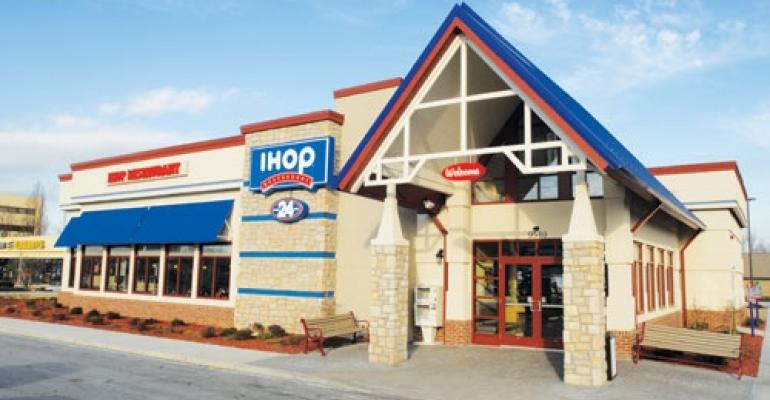After revitalization efforts paid off in increased sales at Applebee’s, DineEquity Inc. said it would turn its attention to sister brand IHOP.
Improvements to IHOP’s operations, menu, ambiance and advertising were in the works, DineEquity said Tuesday after reporting that same-store sales fell 2.7 percent at the family-dining chain in the first quarter.
Meanwhile, same-store sales for the March-ended quarter were up 3.9 percent at domestic locations of Applebee’s Neighborhood Grill & Bar, which has undertaken revitalization efforts for its menu and marketing in recent years.
Hoping to turn around sales at IHOP, Glendale, Calif.-based DineEquity said it conducted segmentation research on the brand, asking guests what they liked and didn’t like, as well as what they’d like to see more of.
“There wasn’t anything I saw in the research that we can’t affect or fix,” Julia Stewart, DineEquity’s chief executive, said Tuesday in a conference call with investors.
In addition to restaurant improvements at IHOP, DineEquity said it would debut eight frozen breakfast products in about 3,000 Walmart stores next week with the goal of “extending the reach of the IHOP brand,” Stewart said.
DineEquity, which operates and franchises 2,011 Applebee’s units and 1,513 IHOPs, said net income more than doubled to $28.1 million, or $1.53 per share, for the first quarter, compared with $12.8 million, or 75 cents per share, a year ago.
Included in the increase were gains resulting from the completed sale of 65 corporate Applebee’s locations during the quarter, as well as the elimination of the dividend on Series A perpetual preferred stock and lower non-cash interest.
Results were partially offset by expenses tied to the repricing of a credit facility in February, lower segment profit after the refranchising of 148 restaurants over the past two quarters, and impairments from the previously announced termination of the sublease on Applebee’s Lenexa, Kan., headquarters.
Revenue in the first quarter declined to $300 million from $358 million in the year-ago period.
DineEquity reduced its debt by 8.8 percent, or $178.6 million, during the quarter, Stewart said.
“We are very pleased with the progress made in the first quarter toward several strategic goals, including revitalizing the Applebee’s brand and reducing our debt,” Stewart said. “The cache of both the IHOP and Applebee’s brands continues to grow.”
Higher gas prices and commodity inflation did not impact first quarter results, Stewart said, though she reiterated an earlier expressed view that both Applebee’s and IHOP have room for menu price increases to offset higher commodity costs in the future.
During the first quarter, Applebee’s continued to benefit from later hours and a renewed emphasis on the bar, as well as a lunch offer that included soup, salad and breadsticks starting at $5.99 and the under-550 calorie menu line, Stewart said.
Franchised Applebee’s locations reported an even-better same-store sales increase of 4.3 percent for the quarter, compared with the same-store sales increase of 0.7 percent for corporate locations.
Stewart said corporate units were hurt in part by bad weather in Michigan and New England, but the varying results also reflected “the reality that we’re getting out of that business.”
As part of the company’s ongoing plan to shift to a nearly all-franchised system, the sale of 65 corporate Applebee’s locations in St. Louis, parts of Illinois and Washington, D.C., was completed during the quarter resulting in after-tax proceeds of $53 million and reduced sale-leaseback-related obligations by $33 million.
Seven corporate Applebee’s restaurants were closed during the quarter, DineEquity said. Franchisees are expected to open between 24 and 28 new Applebee’s locations this year, about half of which will be in international locations.
As a result of Applebee’s improved performance, the company upgraded the outlook for that brand’s domestic locations, projecting that same-store sales for the year will rise between 2 percent and 4 percent. Previously, DineEquity had projected an increase ranging from 1 percent to 3 percent at the chain.
Applebee’s was favorably impacted by the shift of the Easter holiday to the second quarter, DineEquity said, though IHOP was negatively impacted. Excluding the Easter shift, IHOP’s same-store sales would have been down 2.3 percent, DineEquity said.
Still, IHOP’s sales decline did reflect a higher average guest check, though the chain saw declines in traffic. Stewart said the “All-You-Can-Eat Pancakes” limited-time offer in January did not resonate with guests, though the Chicken & Waffles promotion that followed was promising.
The company reiterated projections that IHOP’s same-store sales for the year would range between up 1 percent to down 2 percent. This year IHOP franchisees are expected to open between 55 and 65 new locations, mostly in the United States.
Contact Lisa Jennings at [email protected].

